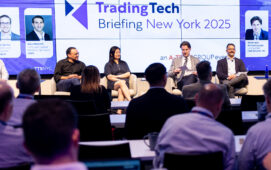
 By Yousaf Hafeez, Head of Business Development for Financial Solutions at BT
By Yousaf Hafeez, Head of Business Development for Financial Solutions at BT
If you think that market data volumes are high today, you’ve seen nothing yet!
With virtual reality (VR) tools for trading edging closer to becoming practically usable on trading floors, any larger scale uptake of such applications will mean an exponential rise in data sourcing and processing. VR therefore poses significant opportunities for traders, but there are challenges to consider too.
At a high-level, VR can be defined as an environment comprising of sounds and images created by a computer that a person can interact with. VR tools catering for the needs of traders have been around for a while but their uptake has been somewhat slow due to limitations of the existing headsets. Nevertheless, the available technology has progressed significantly over the past few years and the applicability of VR in capital markets is not as far-fetched it may seem. As far back as 2016, Trading Advantage placed a commodity trade using VR and Citi launched a proof of concept virtual trading desk, while in the following year Flextrade announced their FlexAR application and SwissQuote launched a VR trading application. In late 2020, UBS announced that it wasexperimenting with virtual trading floors in order to equip its traders – who due to the pandemic were working from home at the time – with the experience of working in the usual trading floor environment.
VR offers the potential for click-and-point professional traders and also retail traders to access unlimited amount of data sets,including real-time, historical, index, alternative, reference, analytics, risk, newsfeeds and derived data. The main appeal of the VR world for users is the fact that it is not limited by the number of physical screens. A user can add or remove screens at will giving them the ability to interact with data that may have been previously unimaginable.
VR permits users to create their own trading room or alternatively enter a virtual trading floor created by someone else, such as a broker. In this virtual trading room, the number and the size of screens is only limited by the user or the developer of the floor. Each screen could show a different data stream, with the user being able to visualise the data in new ways, including dashboards, heatmaps, charts, tables, infograms, etc.; build bespoke charts and analysis; and have the ability to augment their analysis with new data with very little or no programming skills.
That said, it’s very easy to overhype the benefits of VR applications when it comes to utilising market data. In truth, many of these so-called benefits are no more than features that can probably be carried out just as well in a non-VR environment. As an example, VR chatrooms and meetings that many of these tools facilitate can be done just as well over Teams, Webex or Zoom today. This will of course change over time as technology evolves further.
For VR tools to become a permanent fixture in the trading world, a number of challenges need to be addressed.
First and foremost, more data will need to be sourced, processed and stored than ever before. In a highly regulated industry like financial services, where firms need to ensure that practically every data exchange can be traceable and stored appropriately for regulatory use, this signifies a substantial difficulty. It’s also important to consider that VR technology further compounds the challenge of data storage as it multiplies the volume of derived data – as all VR-trading sessions will need to be recorded and stored – and analysis of the data, which also needs to be stored. What is more, in order to power the VR platform low latency data feeds and the ability to route orders to the appropriate venue will be required, in addition to a co-location and/or appropriate compute and storage environment.
Another key limiting factor will likely be the cost of data. The issue of high and continuously rising market data costs has been widely reported. A recent report by the Association for Financial Markets in Europe (AFME) and Expand Research, looking at market data in the fixed income markets, found that its cost rose by 50% from 2017 to 2021. With VR trading environments necessitating even more market data feeds, the cost can be a significant limiting factor to the uptake of such tools.
Furthermore, solutions that do not currently exist will need to be developed to accommodate the data ingestion and data visualisation. No doubt, financial technology firms will rise up to the challenge so we are likely to see new solutions appear in the short- to mid-term.
Last but not least, ensuring cyber security of VR trading environments will be of paramount importance. Firms will need to consider ways of safeguarding their virtual trading floors, and new security technology and processes will likely be required.
Despite these challenges, the benefits of VR in market data provision are potentially huge for both the users and the producers of the data. It remains to be seen as to when the currently still bulky VR gear will become ubiquitous on the trading floor, but based on what we have seen so far, financial services are determined to make VR the reality for future traders.
Subscribe to our newsletter




